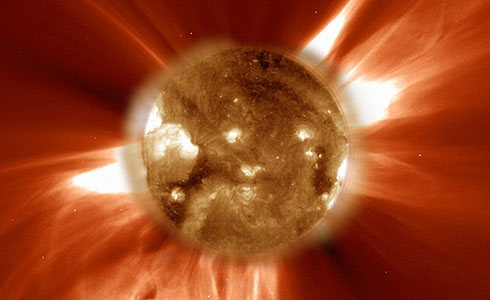Solar storms of that intensity are very rare. Yet, if they occur, their impact can be disastrous: at worst, they can cut off the supply of electricity to entire regions for days on end. Satellite operators and airlines are also at risk. Allianz.com talked to Michael Bruch, risk consultant at the industrial insurer Allianz Global Corporate & Speciality to find out more about the threat posed by such solar phenomena.
"A solar storm like the one from 1859 would be a mega-disaster"
So which measures were taken in Hamburg after the storm tide of 1962? Could this sort of catastrophe repeat itself today?
Bruch: At present, this is still rather difficult. Scientists at the German Aerospace Center or the European Space Agency are working on early warning systems. Using sun observatories and helioseismologic methods that work in similar ways to earthquake forecasts, smaller radiation storms can be forecast two days, major ones at least one day in advance.
What happens then?
Bruch: If there is an eruption, you get a radiation flare that can be detected on earth a few minutes later. Polar lights caused by the interaction between the highly energetic plasma particles and the earth's atmosphere can be seen 24 to 36 hours later. As a rule, solar storms last for two to four days.
How would a solar storm affect us?
Bruch: Solar storms can cause massive damage to the high-voltage transformers that are crucial to our electricity supply. They can raise temperatures in the transformer coils up to 200 degrees Celsius, so that the coolants evaporate and the transformers literally melt. There are no replacements for such transformers available and repairing them can take days or even weeks. Northern latitudes, particularly the United States and Canada, are especially at risk. These regions are particularly vulnerable to short circuits because of the geological composition of the soil and the extremely long power lines they use.


The sun follows different rhythms, with calm and active phases alternating every 11 years. From now until the end of 2013 we will be in a highly active phase, with the likelihood of solar storms increasing significantly. (Photo: NASA)
Has that ever happened before?
Bruch: In the Canadian province of Quebec in 1989 a solar storm interrupted the electricity supply to six million people for a whole of nine hours - at minus 15 degrees Celsius. The blackout wreaked havoc, because it caused traffic guidance systems, airports and district heating to shut down. The damage caused amounted to several million US dollars.
That must have been a pretty strong storm...
Bruch: It was by no means a record. The most intense solar storm ever recorded hit the northern hemisphere in 1859. From Rome to Havana people were admiring the polar lights, sparks and flames were flying from telegraph lines. At the time there still was no major electricity grid, no internet and no digitalization. Nowadays such a solar storm would be a mega-disaster, and a country such as the United States would take years to recover.
Apart from the energy supply, what else is at risk?
Bruch: The high-energy particles released during solar storms can cause severe damage to satellites. At least for older-generation satellites, they are able to penetrate the outer layer and destroy the satellites' electronic systems. This, in turn, can disrupt GPS reception which modern air and shipping navigation systems need.
Then there are the airplanes themselves. They would have an increased risk of radiation, particularly when they are flying close to the poles. This can have a negative impact on control systems and put the health of passengers and crew at risk. That's why Delta Airlines diverted its aircraft on the America-Asia route to a southern course during a solar storm in January this year.
Can we take protective action against solar storms?
Bruch: The latest generations of satellites are protected against highly charged solar particles thanks to innovative materials, special design and redundant electronic systems. By contrast, energy suppliers and operators of electricity grids face greater challenges. Protecting against geomagnetically induced currents and installing replacement transformers are both extremely costly measures and difficult to implement in practice.
So grid operators don't have a lot of easy options?
Bruch: What would seem to make more sense is the development of appropriate early warning systems, because these would allow us to shut down areas of the gird that are at a particular risk or to utilize grid capacities in other ways. Unfortunately, though, steps like these are still in their infancy.
As with all content published on this site, these statements are subject to our Forward Looking Statement disclaimer.
Link to the disclaimer